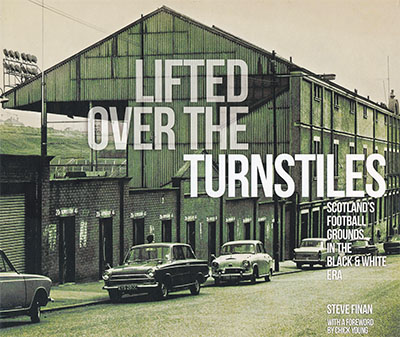
by Steve Finan
DC Thomson, £15.99
Reviewed by Kevin Donnelly
From WSC 380, November 2018
Buy the book
On first seeing this book, I worried that it might be another homage to the “golden age” of Scottish football, where everything, invariably, was so much better than it is now. Thankfully Steve Finan’s Lifted Over The Turnstiles avoids wallowing in nostalgia. A fantastic range of images, supported by some interesting newspaper articles and informative text, quickly dispensed any fears of a lament to times past.
I went straight to the pictures for my hometown club and saw several images of Palmerston in Dumfries that were new to me. At this point, I was actually turning the book 90 degrees to try to work out where things stood then and do now, among numerous images of terraces and stands long gone. The images are significant for what they show in terms of players and fans but also what is not on display. Apart from women in the crowd scenes, the other notable absentee is roofing which, along with decent toilet facilities, catering and safety barriers, all appear to be non-essential items in many of the grounds in the photos. As the veteran journalist Chick Young says in the foreword, these are photos of the “good old, bad old days”.
With most of the book’s contents coming from between the 1940s and 1960s, a more modern image can take you by surprise – a photo of what looked like the back of a Gdansk shipyard warehouse circa 1952 is actually the North Stand of Hampden photographed in 1981. Equally astonishing is a photo of Ibrox from the early 1960s where the aerial photo emphasises the whiteness of the uncovered terracing behind the goal. Concrete replacing cinder ash was a sign of changing times. While the majority of images focus on packed or barren terraces and small stands representing an oasis of shelter on the halfway line, some are a commemoration of unique events, such as the Third Lanark player using a pneumatic drill to break up the ice on a frozen pitch. Another bizarre image involves around 100 fans sitting in the skeleton of a new stand at Tannadice with no visible means of accessing the area in which they are sitting.
Some subtler changes are displayed, such as the difference in police helmets between Scotland and England in the chapter relating to Berwick Rangers. The accompanying text explained something I was unaware of, in that their ground, Shielfield Park, is named after William Shiel Dods, a local butcher who gave the club the land to build on.
Scottish football has changed irrevocably since many of the photos were taken. The vast majority of players featured would be Scottish born and, hard though it may be to conceive, most of the grounds may actually have been built with Scottish-produced steel – changes in football only mirror changes in society.